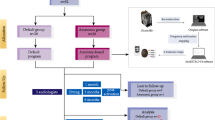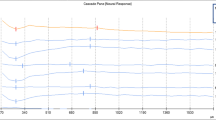Abstract
Objective
To investigate the effect of frequency-to-place mismatch, i.e. the mismatch between the tonotopic frequency map in the cochlea and the frequency band that is assigned to an electrode contact of a cochlear implant (CI) at the same cochlear location on speech perception outcomes, using postoperative CT images.
Study design
Retrospective observational single-centre study.
Methods
Retrospective pre- and postoperative clinical CT data of 39 CI recipients with normal cochlear anatomy were analysed in an otological surgical planning software. The tonotopic frequency at each electrode position was estimated using the Greenwood function. For each patient, frequency-to-place mismatch between the tonotopic frequency and the fitted centre frequency for each electrode contact was calculated. The influence of frequency-to-place mismatch on speech perception in noise at 6 and 12 months after CI activation was studied.
Results
A significant linear correlation was found between the frequency-to-place mismatch and speech perception in noise 6 months after cochlear implantation (p < 0.05). The smaller the frequency-to-place mismatch, the better the initial speech perception in noise results of the CI recipients. The significant effect disappeared after 12 months CI experience.
Conclusion
The study findings support the idea of minimizing the frequency-to-place mismatch in CI recipients in order to pursue better initial speech perception in noise. Further research is needed to investigate the prospect of tonotopic fitting strategies based upon postoperative CT images of the exact locations of the electrode contacts.




Similar content being viewed by others
References
Alexiades G, Dhanasingh A, Jolly C (2015) Method to estimate the complete and two-turn cochlear duct length. Otol Neurotol 36(5):904–907
Baskent D, Shannon RV (2003) Speech recognition under conditions of frequency-place compression and expansion. J Acoust Soc Am 113(4 Pt 1):2064–2076. https://doi.org/10.1121/1.1558357
Baskent D, Shannon RV (2005) Interactions between cochlear implant electrode insertion depth and frequency-place mapping. J Acoust Soc Am 117(3 Pt 1):1405–1416. https://doi.org/10.1121/1.1856273
Buchman CA, Dillon MT, King ER, Adunka MC, Adunka OF, Pillsbury HC (2014) Influence of cochlear implant insertion depth on performance: a prospective randomized trial. Otol Neurotol 35(10):1773–1779. https://doi.org/10.1097/MAO.0000000000000541
Canfarotta MW, Dillon MT, Buss E, Pillsbury HC, Brown KD, O’Connell BP (2019) Validating a new tablet-based tool in the determination of cochlear implant angular insertion depth. Otol Neurotol 40(8):1006–1010. https://doi.org/10.1097/MAO.0000000000002296
Canfarotta MW, Dillon MT, Buss E, Pillsbury HC, Brown KD, O’Connell BP (2020) Frequency-to-place mismatch: characterizing variability and the influence on speech perception outcomes in cochlear implant recipients. Ear Hear 41(5):1349–1361. https://doi.org/10.1097/AUD.0000000000000864
Claes AJ, Van de Heyning P, Gilles A, Van Rompaey V, Mertens G (2018) Cognitive performance of severely hearing-impaired older adults before and after cochlear implantation: preliminary results of a prospective longitudinal cohort study using the RBANS-H. Otol Neurotol. https://doi.org/10.1097/MAO.0000000000001936
Dhanasingh A, Jolly C (2017) An overview of cochlear implant electrode array designs. Hear Res 356:93–103. https://doi.org/10.1016/j.heares.2017.10.005
Dillon MT, Canfarotta MW, Buss E, O’Connell BP (2021) Comparison of speech recognition with an organ of corti versus spiral ganglion frequency-to-place function in place-based mapping of cochlear implant and electric-acoustic stimulation devices. Otol Neurotol. https://doi.org/10.1097/MAO.0000000000003070
Duverney JG (1683) Traité de l'organe de l'ouie, contenant la structure, les usages & les maladies de toutes les parties de l'oreille. Langerak, Paris
Fitzgerald MB, Sagi E, Jackson M, Shapiro WH, Roland JT Jr, Waltzman SB, Svirsky MA (2008) Reimplantation of hybrid cochlear implant users with a full-length electrode after loss of residual hearing. Otol Neurotol 29(2):168–173. https://doi.org/10.1097/mao.0b013e31815c4875
Fu QJ, Shannon RV (1999) Recognition of spectrally degraded and frequency-shifted vowels in acoustic and electric hearing. J Acoust Soc Am 105(3):1889–1900. https://doi.org/10.1121/1.426725
Fu QJ, Shannon RV, Galvin JJ 3rd (2002) Perceptual learning following changes in the frequency-to-electrode assignment with the nucleus-22 cochlear implant. J Acoust Soc Am 112(4):1664–1674. https://doi.org/10.1121/1.1502901
Greenwood DD (1991) Critical bandwidth and consonance in relation to cochlear frequency-position coordinates. Hear Res 54(2):164–208. https://doi.org/10.1016/0378-5955(91)90117-r
Hochmair I, Arnold W, Nopp P, Jolly C, Muller J, Roland P (2003) Deep electrode insertion in cochlear implants: apical morphology, electrodes and speech perception results. Acta Otolaryngol 123(5):612–617
Holden LK, Finley CC, Firszt JB, Holden TA, Brenner C, Potts LG, Gotter BD, Vanderhoof SS, Mispagel K, Heydebrand G, Skinner MW (2013) Factors affecting open-set word recognition in adults with cochlear implants. Ear Hear 34(3):342–360. https://doi.org/10.1097/AUD.0b013e3182741aa7
Kalkman RK, Briaire JJ, Dekker DM, Frijns JH (2014) Place pitch versus electrode location in a realistic computational model of the implanted human cochlea. Hear Res 315:10–24. https://doi.org/10.1016/j.heares.2014.06.003
Landsberger DM, Svrakic M, Roland JT Jr, Svirsky M (2015) The relationship between insertion angles, default frequency allocations, and spiral ganglion place pitch in cochlear implants. Ear Hear 36(5):e207-213. https://doi.org/10.1097/AUD.0000000000000163
Li T, Fu QJ (2010) Effects of spectral shifting on speech perception in noise. Hear Res 270(1–2):81–88. https://doi.org/10.1016/j.heares.2010.09.005
Mertens G, Van Rompaey V, Van de Heyning P, Gorris E, Topsakal V (2020) Prediction of the cochlear implant electrode insertion depth: clinical applicability of two analytical cochlear models. Sci Rep 10(1):3340. https://doi.org/10.1038/s41598-020-58648-6
Pelizzone M, Cosendai G, Tinembart J (1999) Within-patient longitudinal speech reception measures with continuous interleaved sampling processors for ineraid implanted subjects. Ear Hear 20(3):228–237. https://doi.org/10.1097/00003446-199906000-00005
Reiss LA, Turner CW, Erenberg SR, Gantz BJ (2007) Changes in pitch with a cochlear implant over time. J Assoc Res Otolaryngol 8(2):241–257. https://doi.org/10.1007/s10162-007-0077-8
Reiss LA, Turner CW, Karsten SA, Gantz BJ (2014) Plasticity in human pitch perception induced by tonotopically mismatched electro-acoustic stimulation. Neuroscience 256:43–52. https://doi.org/10.1016/j.neuroscience.2013.10.024
Schurzig D, Timm ME, Batsoulis C, Salcher R, Sieber D, Jolly C, Lenarz T, Zoka-Assadi M (2018) A novel method for clinical cochlear duct length estimation toward patient-specific cochlear implant selection. OTO Open 2(4):2473974X18800238. https://doi.org/10.1177/2473974x18800238
Shallop JK, McGinn-Brunelli T (1995) Speech recognition performance over time with the spectra 22 speech processor. Ann Otol Rhinol Laryngol Suppl 166:306–307
Stakhovskaya O, Sridhar D, Bonham BH, Leake PA (2007) Frequency map for the human cochlear spiral ganglion: implications for cochlear implants. J Assoc Res Otolaryngol 8(2):220–233. https://doi.org/10.1007/s10162-007-0076-9
Svirsky MA, Silveira A, Neuburger H, Teoh SW, Suarez H (2004) Long-term auditory adaptation to a modified peripheral frequency map. Acta Otolaryngol 124(4):381–386
van Wieringen A, Wouters J (2008) LIST and LINT: sentences and numbers for quantifying speech understanding in severely impaired listeners for Flanders and the Netherlands. Int J Audiol 47(6):348–355. https://doi.org/10.1080/14992020801895144
Venail F, Mathiolon C, Menjot de Champfleur S, Piron JP, Sicard M, Villemus F, Vessigaud MA, Sterkers-Artieres F, Mondain M, Uziel A (2015) Effects of electrode array length on frequency-place mismatch and speech perception with cochlear implants. Audiol Neurootol 20(2):102–111. https://doi.org/10.1159/000369333
Von Békésy G (1944) Uber die mechanisme Frequenzanalyse in der Schnecke verschiedener Tiere. Akust Zeits 9:3–11
Wilson BS, Finley CC, Lawson DT, Wolford RD, Eddington DK, Rabinowitz WM (1991) Better speech recognition with cochlear implants. Nature 352(6332):236–238. https://doi.org/10.1038/352236a0
Wurfel W, Lanfermann H, Lenarz T, Majdani O (2014) Cochlear length determination using cone beam computed tomography in a clinical setting. Hear Res 316:65–72. https://doi.org/10.1016/j.heares.2014.07.013
Funding
This study involved funding received from MED-EL to Griet Mertens.
Author information
Authors and Affiliations
Corresponding author
Ethics declarations
Conflict of interest
Research grant from MED-EL (Innsbruck, Austria) paid to the institution. The research protocol, which involves human participants, was approved by the ethics committee of the Antwerp University Hospital on September 9th 2017 (Protocol Number 17/35/395). Since only retrospective clinical data were used, the committee waived the need to obtain informed consents for this study.
Additional information
Publisher's Note
Springer Nature remains neutral with regard to jurisdictional claims in published maps and institutional affiliations.
Rights and permissions
About this article
Cite this article
Mertens, G., Van de Heyning, P., Vanderveken, O. et al. The smaller the frequency-to-place mismatch the better the hearing outcomes in cochlear implant recipients?. Eur Arch Otorhinolaryngol 279, 1875–1883 (2022). https://doi.org/10.1007/s00405-021-06899-y
Received:
Accepted:
Published:
Issue Date:
DOI: https://doi.org/10.1007/s00405-021-06899-y




